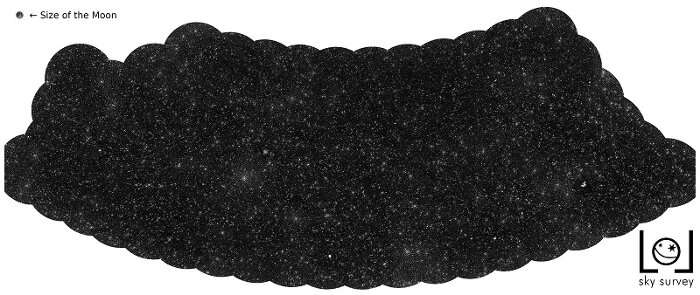Astronomers publish map showing 25,000 supermassive black holes

An international team of astronomers has published a map of the sky showing over 25,000 supermassive black holes. The map, to be published in the journal Astronomy & Astrophysics, is the most detailed celestial map in the field of so-called low radio frequencies. The astronomers, including Leiden astronomers, used 52 stations with LOFAR antennas spread across nine European countries.
Stars or black holes?
To an untrained eye, the sky map appears to contain thousands of stars, but they are actually supermassive black holes. Each black hole is located in a different, distant galaxy. The radio emissions are emitted by matter that was ejected as it got close to the black hole.
Research leader Francesco de Gasperin (formerly Leiden University, now Universität Hamburg, Germany) says about the study: "This is the result of many years of work on incredibly difficult data. We had to invent new methods to convert the radio signals into images of the sky."
From the bottom of the pool
Observations at long radio wavelenghts are complicated by the ionosphere that surrounds the Earth. This layer of free electrons acts like a cloudy lens that constantly moves across the radio telescope. Co-author Reinout van Weeren (Leiden Observatory) explains: "It's similar to when you try to see the world while immersed in a swimming pool. When you look up, the waves on the water of the pool deflect the light rays and distort the view."
Map of the entire sky
The new map was created by combining 256 hours of observations of the northern sky. The researchers deployed supercomputers with new algorithms that correct the effect of the ionosphere every four seconds. Scientific Director of the Leiden Observatory Huub Röttgering is the last author of the publication. He is delighted with the results: "After many years of software development, it is so wonderful to see that this has now really worked out."
The map now covers 4 percent of the northern half of the sky. The astronomers plan to continue until they have mapped the entire northern sky. In addition to supermassive black holes, the map also provides insight into the large-scale structure of the universe, among other things.
More information: The LOFAR LBA Sky Survey - I. survey description and preliminary data release. Accepted for publication in Astronomy & Astrophysics. www.astronomie.nl/upload/files … perin-AandA-2021.pdf
Journal information: Astronomy & Astrophysics
Provided by Leiden University





















